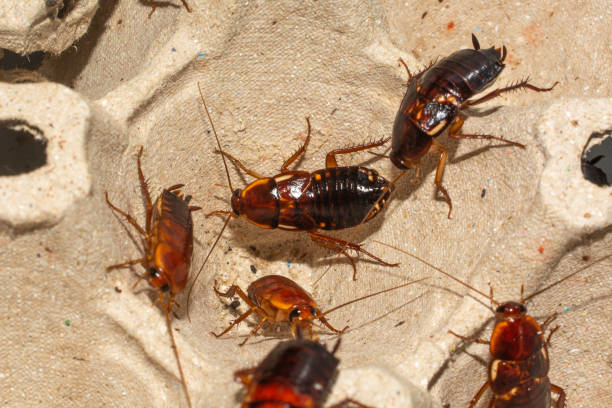
Brown Banded Cockroach Pest Control in Toronto

Signs of an infestationThis type of cockroaches are nocturnal, meaning they are active at night and hide during the day. They prefer warm and dry locations, such as cabinets, closets, attics, furniture, appliances, and electronics. They can also be found in bedrooms and living rooms, unlike some other roach species that need more moisture. They feed on a variety of organic materials, such as starches, glue, paper, leather, hair, and dead insects.
Some signs that indicate the presence of Brown-Banded cockroaches are:
Visual sightings of live or dead roaches, especially at night when they come out to search for food and water.
Droppings that look like small black specks or pepper grains, often found near their hiding places or along the edges of walls and furniture.
Eggs that are dark brown, oval-shaped, and about a quarter of an inch long. The female carries the egg capsule for a few days before attaching it to a hidden surface. Each capsule contains 10 to 18 eggs.
A musty odor that is produced by their feces and secretions. This smell can become stronger as the infestation grows.
Brown-Banded Cockroaches removalGetting rid of Brown-Banded cockroaches can be challenging, as they can hide in many places and survive without water for long periods. Some steps that can help eliminate these pests are:
Cleaning the house thoroughly and regularly, especially the areas where they are likely to hide or feed. Vacuuming, sweeping, wiping, and sanitizing can remove their food sources and droppings.
Sealing off any cracks, holes, gaps, or crevices in the walls, floors, ceilings, doors, windows, pipes, wires, or vents that can serve as entry points or hiding spots for the roaches.
Setting out baits, traps, or insecticides that are designed to attract and kill roaches. These products should be placed near their harborage areas or along their travel paths. Follow the instructions and precautions on the labels carefully.
Contact a professional pest control service if the infestation is severe or difficult to control. They can use more effective methods and products to eradicate the roaches.
How to prevent Brown-Banded Cockroaches from invadingTo prevent Brown-Banded cockroaches from invading the home in the first place, some preventive measures are:
Inspecting any items that are brought into the home for signs of roach infestation, such as eggs, droppings, or live roaches. These items can include groceries, packages, luggage, furniture, appliances, or plants.
Storing food in sealed containers or in the refrigerator. Avoid leaving food crumbs or spills on the counters, tables, floors, or sinks.
Repairing any leaks or drips in the plumbing or faucets that can provide water for the roaches.
Ventilating and dehumidifying the rooms that are prone to high humidity or temperature, such as bathrooms, kitchens, laundry rooms, or basements.
Discarding any clutter or trash that can attract or harbor roaches. This includes cardboard boxes, paper bags, newspapers, magazines, books, clothing, or fabrics.
Habitat, Diet, and Life CycleBrown-Banded cockroaches are native to Africa but have spread to other parts of the world through human activity. They can be found in various indoor environments where they can find food and shelter.
They are omnivorous and will eat almost anything that is organic. They prefer starchy foods such as breads, cereals, crackers, or cookies. They also feed on glue, paper, leather, hair, nails, or dead insects.
Have a typical cockroach life cycle of egg, nymph, and adult stages. The female produces 12 to 16 egg capsules in her lifetime, each containing 10 to 18 eggs1. The eggs hatch in about 50 to 75 days, depending on the temperature and humidity. The nymphs go through seven to nine molts before reaching adulthood in about three to six months. The adults can live for four to ten months.
Commonly Asked Questions:
Are Brown-Banded cockroaches dangerous ?They are not directly harmful to humans, but they can pose health risks by contaminating food and surfaces with their droppings, saliva, or body parts. They can also carry and transmit bacteria, viruses, fungi, parasites, or allergens that can cause diseases or allergic reactions in humans or pets.
How do I tell the difference between Brown-Banded cockroaches and German cockroaches ?Brown-Banded cockroaches and German cockroaches are similar in size and shape, but they have some distinctive features that can help identify them. Brown-Banded cockroaches have two light brown bands on their wings and abdomen, while German cockroaches have two dark stripes on their head and thorax. Brown-Banded cockroaches prefer warm and dry locations, while German cockroaches prefer moist and warm locations. Brown-Banded cockroaches can survive longer without water, while German cockroaches need water more frequently. Brown-Banded cockroaches are less common than German cockroaches in most areas
When to call an Brown Banded cockroach exterminator ?The best is to call us as soon as possible. We service the Greater Toronto Area, call us now 647 849 4441
Brown Banded Cockroach
PEST CONTROL
GTA Exterminators for Brown Banded cockroach removal in Toronto
Call us today for Brown Banded cockroach extermination
